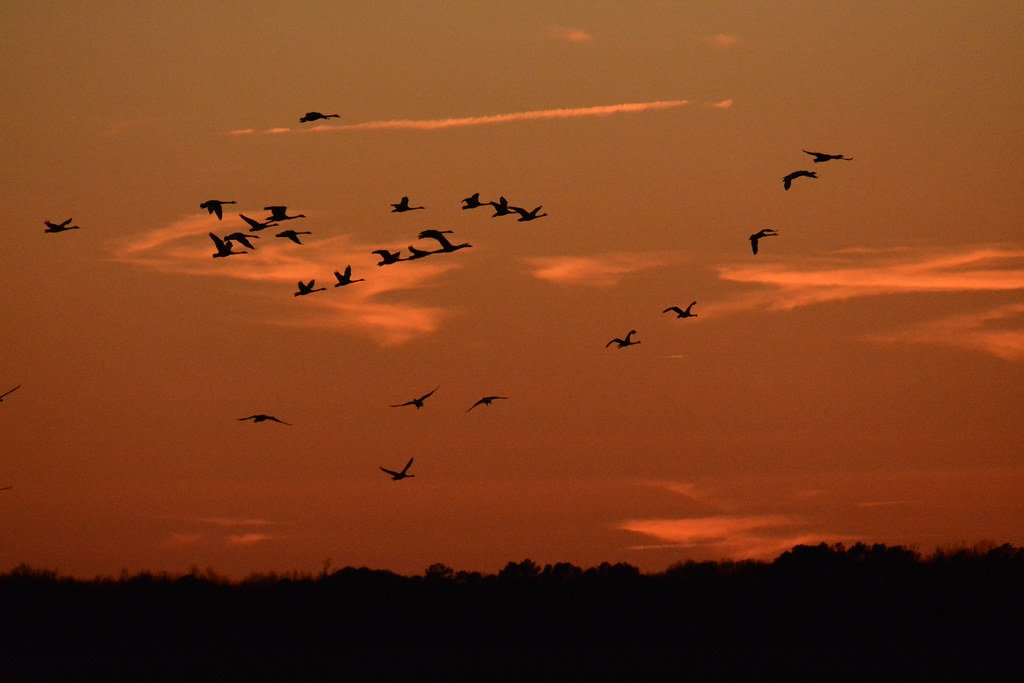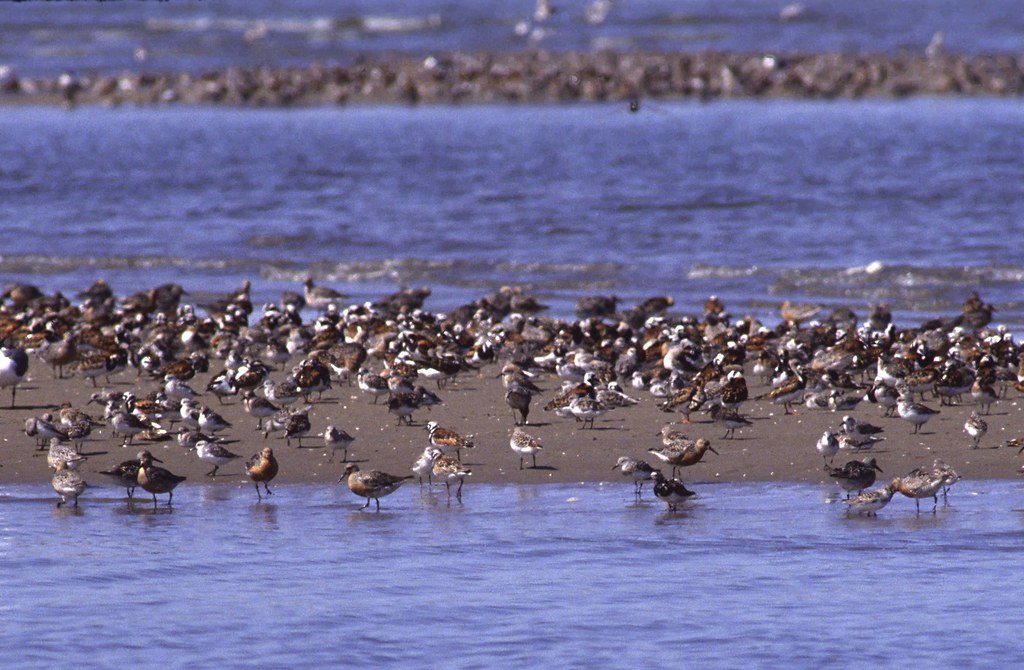Picture this: It’s a crisp autumn morning, and you look up to see thousands of geese flying in perfect V-formation across the sky. They’re heading south with unwavering determination, following invisible highways in the sky. But here’s what’s mind-blowing – these birds didn’t check weather apps or consult migration schedules. They just knew it was time to go. This ancient dance between birds and seasons has puzzled humans for centuries, and the answers are far more extraordinary than you might imagine.
The Internal Clock That Never Needs Winding

Deep within every migratory bird lies a biological masterpiece called the circadian rhythm. This internal timekeeper operates like the world’s most sophisticated clock, ticking away based on changes in daylight hours. When days grow shorter in fall, specialized cells in a bird’s brain detect these shifts with incredible precision. The pineal gland, often called the “third eye,” plays a crucial role by producing melatonin in response to darkness. This hormone surge triggers a cascade of physiological changes that prepare birds for their epic journeys. Think of it as nature’s own alarm system that never hits the snooze button.
Weather Patterns: Nature’s Migration Calendar

Birds are essentially living weather stations, equipped with sensors more accurate than anything humans have created. They can detect minute changes in barometric pressure that signal approaching weather systems days in advance. A dropping pressure often means storms are coming, while rising pressure indicates clear skies ahead – perfect migration conditions. Temperature changes also play a vital role, as birds instinctively know when their food sources will become scarce. Some species can even sense infrasound – ultra-low frequency sound waves produced by weather systems hundreds of miles away. It’s like having a crystal ball that predicts the perfect travel conditions.
The Magnetic Highway System

Perhaps the most astounding navigation tool birds possess is their ability to detect Earth’s magnetic field. Specialized cells containing magnetite crystals act like tiny compasses embedded in their beaks and inner ears. These biological GPS systems allow birds to sense magnetic variations across the planet with remarkable accuracy. The magnetic field lines create invisible highways that guide birds along their traditional migration routes. Even more fascinating, young birds can inherit magnetic “maps” from their parents, learning the safest and most efficient pathways. This magnetic navigation system works even on cloudy nights when stars aren’t visible.
Food Scarcity: The Hunger Signal

When your favorite restaurant runs out of your go-to meal, you find another place to eat. For birds, it’s not quite that simple. As seasons change, insect populations crash, seeds become buried under snow, and nectar sources dry up. Birds have evolved to recognize these early warning signs of food shortages before they become life-threatening. Their bodies begin storing extra fat reserves weeks before migration, almost like packing snacks for a very long road trip. Some species will even change their diet completely, switching from insects to berries to build up the energy reserves needed for thousands of miles of flight.
Social Cues and Community Decisions

Migration isn’t always a solo act – many bird species rely on community wisdom to make the big decision. Young birds often depend on experienced elders to guide them along established routes. Flocking behavior serves as both protection and navigation aid, with older birds teaching migration timing to newcomers. Communication through calls and visual signals helps coordinate departure times among groups. Some species even have “scout birds” that leave early to test conditions and report back to the flock. It’s like having a travel advisory committee where experience trumps individual instinct.
Hormonal Changes: The Chemical Compass

The bird’s endocrine system orchestrates migration through a complex symphony of hormones. Corticosterone levels spike during pre-migration periods, triggering restless behavior called “zugunruhe” – literally meaning “migration anxiety” in German. Testosterone and estrogen fluctuations also influence migration timing, particularly in breeding-related movements. These hormonal surges affect everything from appetite changes to fat storage patterns. The thyroid gland releases hormones that boost metabolism, giving birds the energy needed for extended flight. It’s essentially nature’s way of giving birds a chemical boost when they need it most.
Celestial Navigation: Following the Stars

Long before humans invented the compass, birds were using the stars as their roadmap. Many species can recognize specific star patterns and use them for navigation during nighttime flights. The North Star serves as a particularly important reference point for birds in the Northern Hemisphere. Even more impressive, birds can compensate for the Earth’s rotation, adjusting their star-based navigation throughout the night. Young birds learn these celestial patterns during their first migration season, creating a mental star map for future journeys. Cloud cover doesn’t completely disable this system, as birds can detect polarized light patterns invisible to human eyes.
The Role of Genetics in Migration Timing

Migration behavior is literally written in birds’ DNA, passed down through thousands of generations. Specific genes control everything from migration timing to route preferences and distance traveled. Scientists have identified “migration genes” that influence when birds feel the urge to move. These genetic programs can be so precise that birds from the same species but different regions will migrate at slightly different times. Environmental factors can even trigger genetic switches that activate or suppress migration behaviors. It’s like having a detailed travel itinerary encoded in your cells from birth.
Learning from Experience: The Migration Memory Bank

Each migration journey adds valuable information to a bird’s mental database. Experienced migrants remember specific landmarks, favorable weather patterns, and reliable food sources along their routes. Birds can recall dangerous areas where predators lurk or storms frequently occur. This experiential learning allows older birds to make better timing decisions with each passing year. Some species even remember successful migration years and attempt to replicate those conditions. Young birds traveling with experienced adults receive this knowledge through observation and following behavior.
Environmental Triggers Beyond Weather

Migration timing isn’t just about temperature and storms – birds respond to subtle environmental changes that humans barely notice. Soil temperature affects insect emergence, which influences insectivorous birds’ departure times. Even the smell of changing vegetation can trigger migration responses in some species. Air pressure variations that occur days before weather changes provide early departure signals. Some birds respond to changes in humidity levels that indicate seasonal shifts. The angle of sunlight also plays a role, as it affects both day length calculations and the intensity of solar radiation birds experience.
The Impact of Climate Change on Migration Patterns

Global climate change is scrambling the ancient signals that birds have relied upon for millennia. Rising temperatures are causing some species to delay their migration or skip it entirely in warmer years. Traditional food sources are appearing at different times, creating mismatches between bird arrival and peak food availability. Some birds are adapting by shortening their migration distances, while others are extending their routes to find suitable conditions. Extreme weather events are also disrupting normal migration patterns, forcing birds to develop new strategies. These changes are happening faster than evolution can keep up with, creating unprecedented challenges for migratory species.
Technology Reveals Migration Secrets

Modern technology has revolutionized our understanding of bird migration timing. Satellite tracking devices now allow scientists to follow individual birds throughout their entire journeys. GPS tags reveal that birds make incredibly complex decisions about when to start, stop, and change course during migration. Weather radar systems can detect massive bird movements in real-time, showing how weather influences departure timing. Light-sensitive geolocators help researchers understand how birds use daylight patterns for navigation. These technological advances continue to reveal new aspects of migration timing that were previously invisible to human observation.
Species-Specific Migration Calendars

Different bird species operate on remarkably precise migration schedules that rarely vary by more than a few days each year. Arctic terns follow a schedule so exact that they arrive at breeding grounds within the same week annually. Ruby-throated hummingbirds time their migration to coincide with peak nectar availability along their routes. Sandhill cranes gather at specific stopover sites on nearly identical dates each spring and fall. These species-specific calendars have evolved over thousands of years to optimize survival and breeding success. Even closely related species may have completely different migration timing based on their unique ecological needs.
The Energetics of Migration Timing

Birds must balance energy expenditure with energy availability when deciding migration timing. Flying too early means facing harsh weather and limited food sources, while leaving too late risks being caught in dangerous storms. Optimal migration timing maximizes favorable wind conditions that can reduce energy costs by up to 50%. Birds time their departures to take advantage of thermal updrafts and tailwinds that make long-distance flight more efficient. Fat reserves must be carefully managed throughout the journey, requiring precise timing of departure and stopovers. This energy equation is so critical that even small timing mistakes can mean the difference between survival and death.
Human Impact on Migration Timing

Urban development and artificial lighting are increasingly interfering with natural migration timing cues. City lights can confuse birds’ circadian rhythms and celestial navigation systems. Window strikes peak during migration periods when birds are disoriented by building lights. Climate-controlled environments around cities create “heat islands” that may delay departure timing for urban bird populations. Noise pollution from traffic and industry can mask important acoustic cues that birds use for migration coordination. These human influences are forcing birds to adapt their timing strategies in ways that may not always be beneficial for their survival.
The Future of Migration Research

Scientists are developing new methods to predict and understand migration timing with unprecedented accuracy. Artificial intelligence is being used to analyze vast amounts of migration data and identify patterns invisible to human researchers. Genetic sequencing technology may soon allow researchers to predict individual birds’ migration timing based on their DNA. Climate modeling helps predict how future environmental changes will affect traditional migration patterns. Citizen science projects are engaging thousands of volunteers to track bird movements and report timing observations. These advancing research methods promise to unlock even more secrets about how birds know when to migrate.
Conservation Implications of Migration Timing

Understanding migration timing is crucial for protecting critical habitats when birds need them most. Conservation efforts must account for the precise timing of peak migration periods to be effective. Protected areas along migration routes need to maintain their resources during specific time windows when birds depend on them. Climate change adaptation strategies for birds must consider how shifting timing affects survival rates. International cooperation is essential since migration timing affects birds across multiple countries and continents. The intricate timing of bird migration serves as an early warning system for broader environmental changes that affect entire ecosystems.
The remarkable ability of birds to know exactly when to migrate represents one of nature’s most sophisticated timing systems. Through millions of years of evolution, birds have developed multiple backup systems that work together to ensure their survival during these incredible journeys. From internal biological clocks to magnetic navigation and social learning, every aspect of migration timing has been fine-tuned for maximum success. As our planet continues to change rapidly, understanding these timing mechanisms becomes more important than ever for conservation efforts. What amazes you most about birds’ ability to navigate these ancient pathways with such precision?



